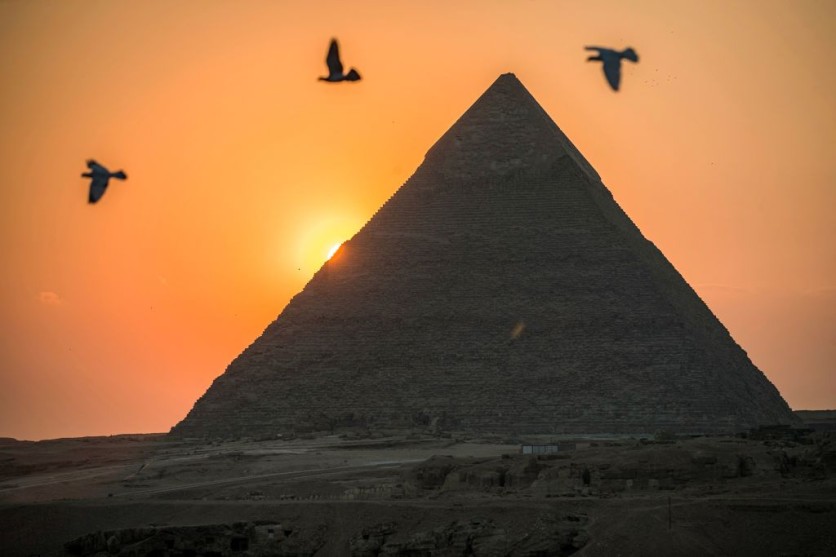A new study reportedly suggests that the world's oldest pyramids were built by the Egyptians using a hydraulic lift to carry the impossibly heavy stones.
The study, which was published in PLOS ONE, claims that the Step Pyramid of Djoser's internal design, canals, and landscape all allude to the hydraulic system.

(Photo : KHALED DESOUKI/AFP via Getty Images)
Pigeons fly in the sky above the Egyptian capital's twin city of Giza on February 21, 2021, with the Pyramid of Khafre (Chephren) in the background.
The widely held belief, as reported by Heritage Daily, is that they used ramps and rollers to lift and position the incredibly huge stones. Researchers discovered evidence of possible hydraulic system use after studying the Djoser in Saqqara, the earliest Egyptian pyramid. This is a considerably more advanced theory that has led to new research directions.
In light of this, the roughly 37-acre King Djoser funeral complex started to take on new life. The enormous, unexplained structure known as the Gisr el-Mudir may have been a check dam designed to hold back water and silt while French experts studied the watersheds in the region.
Read Also : Archaeologists Uncover Extremely Rare 6-Sheep Carriage Near the Mausoleum of China's First Emperor
Ancient Egypt's Hydraulic System
According to LBV, this incredibly sophisticated water management system consists of a purification system, retention basin, and settling basin, among other compartments carved out of rock and connected by a channel. According to Popular Mechanics, this dam might have even produced a man-made lake.
It's possible that they had some sort of hydraulic organization, which attests to their expertise in this field of engineering, but no one was aware of it at the time.
They examined the Djoser's interior structure, including its tunnels, and concluded that it corroborated their theory-which has never been documented before the stones were moved by a hydraulic elevation mechanism that directed water free of sediment up an internal shaft, thereby resembling a volcano.
Moreover, LGV claims that the water supplies available in the region at the time agreed with their calculations of the amount of water power required to construct the pyramid.
Oldest Pyramid
The Step pyramid of Djoser is not the oldest in the world, according to research from the previous year; instead, Gunung Padang is the oldest known pyramid worldwide.
There has reportedly long been debate concerning the origins of Gunung Padang, an extinct volcano in West Java, Indonesia. In particular, there has been debate over whether the structure is predominantly natural with human alterations or predominantly man-made. The place was designated as a cultural heritage site in 1998.
The research team, which included paleontologists, geologists, geophysicists, and archaeologists from various Indonesian institutions, carried out a thorough scientific investigation between 2011 and 2015 using ground-penetrating radar, electrical resistivity tomography, and seismic tomography.
Furthermore, core samples were extracted by drilling, which allowed radiocarbon dating methods to be applied to determine the ages of different strata inside the structure.
After conducting a thorough investigation, the researchers concluded that Gunung Padang was mostly produced by human hands. They also found evidence that the construction happened in discrete stages over thousands of years.
The oldest parts, built between 25,000 and 14,000 years ago, make it the world's oldest known pyramid. The evolution of the building required a series of human endeavors.
At first, people decorated the top of a dormant volcano with molded lava. Then, sometime between 7900 and 6100 BCE, they built a stratum of rock columns and bricks.
They covered over some of the earlier work with Earth at an undisclosed later date. They improved it even more between 2000 and 1100 BCE by adding stone terracing.
The discovery made by the research team points to the possibility of empty areas inside the building, indicating the existence of secret rooms. They intend to use cameras to record the contents of these locations and conduct drilling operations to explore them.

ⓒ 2025 TECHTIMES.com All rights reserved. Do not reproduce without permission.




